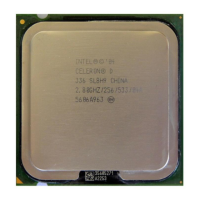Thermal Interface Management
R
Thermal/Mechanical Design Guide 73
Appendix C Thermal Interface
Management
To optimize a heatsink design, it is important to understand the impact of factors related to the
interface between the processor and the heatsink base. Specifically, the bond line thickness,
interface material area and interface material thermal conductivity should be managed to realize
the most effective thermal solution.
C.1 Bond Line Management
Any gap between the processor integrated heat spreader (IHS) and the heatsink base degrades
thermal solution performance. The larger the gap between the two surfaces, the greater the
thermal resistance. The thickness of the gap is determined by the flatness and roughness of both
the heatsink base and the integrated heat spreader, plus the thickness of the thermal interface
material (for example thermal grease) used between these two surfaces and the clamping force
applied by the heatsink attach clip(s).
C.2 Interface Material Area
The size of the contact area between the processor and the heatsink base will impact the thermal
resistance. There is, however, a point of diminishing returns. Unrestrained incremental increases
in thermal interface material area do not translate to a measurable improvement in thermal
performance.
C.3 Interface Material Performance
Two factors impact the performance of the interface material between the processor and the
heatsink base:
• Thermal resistance of the material
• Wetting/filling characteristics of the material
Thermal resistance is a description of the ability of the thermal interface material to transfer heat
from one surface to another. The higher the thermal resistance, the less efficient the interface
material is at transferring heat. The thermal resistance of the interface material has a significant
impact on the thermal performance of the overall thermal solution. The higher the thermal
resistance, the larger the temperature drop is across the interface and the more efficient the
thermal solution (heatsink, fan) must be to achieve the desired cooling.
The wetting or filling characteristic of the thermal interface material is its ability, under the load
applied by the heatsink retention mechanism, to spread and fill the gap between the processor and
the heatsink. Since air is an extremely poor thermal conductor, the more completely the interface
material fills the gaps, the lower the temperature drops across the interface. In this case, thermal

